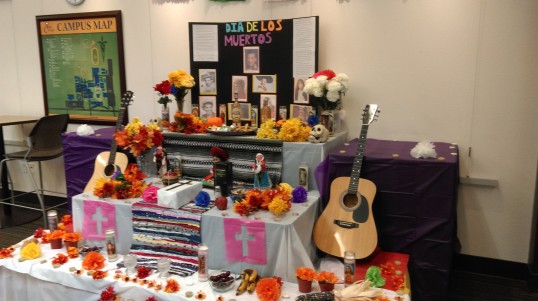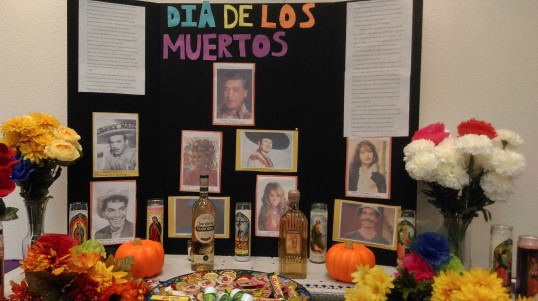
In one of the most recent Crossing Borders Building Bridges events held on Oct. 30, Professor José Ramón Muñoz gave a presentation about Día de los Muertos (Day of the Dead). Titled “Keeping a Tradition Alive,” Professor Muñoz’s speech entailed the holiday’s ancient origin, time-honored practices, and how it became a part of California’s cultural heritage.
Día de los Muertos is a holiday which begins on Oct. 31 and ends on Nov. 2. Over the course of three days, remembrances are held for deceased family and friends. It is officially observed by Mexico, and celebrated throughout Central America, as well as regions in the United States with large Hispanic populations.
“When you’re young, you make a lot of friends,” says Professor Muñoz, “And when you get older, you start to lose a lot of friends […] but Día de los Muertos is not a sad day. It is not a funeral. It is not Mexican Halloween […] it is a day to reflect on your life, your heritage, your ancestors, and the meaning of existence.”
Día de los Muertos recognizes three distinct deaths: the first when a person dies, the second when he or she is buried, and the third when there is no left to remember his or her name. Perhaps it is the fear of dying a third death that makes Día de los Muertos such a vibrant celebration full of stunning imagery, so that one never forgets what it means to alive, even after they themselves have passed away.
The most visual aspect of Día de los Muertos is no doubt the altars put together to honor the dead. Family members display their favorite pictures of their loved ones on the altar, though pictures of the deceased may be not just family, but actors, celebrities, or musicians the person building the altar appreciated. Visiting an altar is similar to visiting a grave as people may leave flowers or stuffed animals. These altars are not used for worship. Rather, they are a site where offerings of love may be given.

There a four offerings commonly given during Día de los Muertos. The first is marigold, a rich orange colored flower that represents death and dying. Salt and water represent continued life thereafter. Copal incense, which is stripped from a resinous tree ingenious to Mexico, seeks to guide spirits to their altars by its alluring scent. Food, especially fruit, is also left at an altar as an offering.
Figurines of skeletons may thematically represent the person who has died. Called “calaca,” these skeletons are dressed in elaborate costume and are depicted as joyous, often times striking a picture-perfect pose, playing instruments, or dancing. It is to symbolize the happiness one will feel in the afterlife. As a tongue-in-cheek joke, calacas are made for politicians that are still alive.

“Calavera” is a depiction of a human skull made out of clay and decorated with flowers. Sugar skulls also exist and are a treat for kids. “Children like to find calaveras with their name on it. It’s a nice gift” says Professor Muñoz, “Día de los Muertos may be more graphic than most holidays remembering the dead, but there is no blood, guts, ghosts, or gore. Children grow up realizing that skeletons aren’t scary.”
After paying respects to the dead, celebrations of are sometimes held in graveyards. “The cemetery is full of life this night!” Professor Muñoz said with a laugh, “Balloons, food, wine… it’s a fiesta!” Sometimes, entire families can spend the night in a cemetery partying and telling stories about their loved ones.
3,000 years ago, various peoples in Mesoamerica such as the Aztecs celebrated the deaths of their ancestors during the ninth month of the Aztec calendar. Corresponding to the Gregorian calendar, this event fell during the first week of August. During the 16th century and at the height of Spain’s colonization of the New World, Spanish influences intermixed with pre-Hispanic culture and traditions. The practice of honoring the dead was incorporated into modern Mexican culture to coincide with All Saints’ Day, a Catholic observance which falls on Nov. 1.
This year’s presentation of Día de los Muertos is the fifth annual celebration for Yuba College and was made possible thanks to Crossing Borders, Building Bridges. Professor Neelam Dhinsa Canto-Lugo who organizes CBBB credits the event series with raising awareness of the holiday as it becomes more pronounced in popular culture, especially with a growing Hispanic community in California.
After the presentation, pan de muerto (bread of the dead) was served to those in attendance. It is a type of sweet roll with a dry texture and buttery taste. Bitter, yet sweet like the holiday itself, perhaps. Though those who have died are no longer here with us physically, our memories keep them alive in their own way.
“There is a saying,” spoke Professor Muñoz, ” Nacimos para morir… we were born to die.”
Note: This article was featured in The Prospector Winter 2014 edition.
I come from a long line of yokels, mostly fishermen and truckers. Some then, find it odd that I am an aspiring economist and sociologist. The way I see it: my family’s tales of the road and the river humbled me, yet caused a thirst for adventure . I also like to write feature stories about interesting places and the beautiful people that live there. Like Yuba-Sutter.
Comment Policy: Comments are welcomed and encouraged. However, the editorial board reserves the right to edit or delete, without notice, any comments submitted to the blog. For more details, see our full Comment Policy.